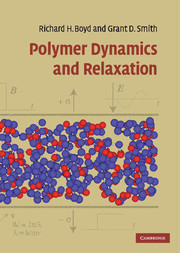Book contents
- Frontmatter
- Contents
- Preface
- Part I Methodology
- 1 Mechanical relaxation
- 2 Dielectric relaxation
- 3 NMR spectroscopy
- 4 Dynamic neutron scattering
- 5 Molecular dynamics (MD) simulations of amorphous polymers
- Part II Amorphous polymers
- Part III Complex systems
- Appendix AI The Rouse model
- Appendix AII Site models for localized relaxation
- Index
- References
3 - NMR spectroscopy
Published online by Cambridge University Press: 10 November 2009
- Frontmatter
- Contents
- Preface
- Part I Methodology
- 1 Mechanical relaxation
- 2 Dielectric relaxation
- 3 NMR spectroscopy
- 4 Dynamic neutron scattering
- 5 Molecular dynamics (MD) simulations of amorphous polymers
- Part II Amorphous polymers
- Part III Complex systems
- Appendix AI The Rouse model
- Appendix AII Site models for localized relaxation
- Index
- References
Summary
Nuclear magnetic resonance (NMR) is the primary spectroscopic technique utilized in the study of polymer dynamics. NMR is in many ways complementary to the scattering (neutron) and relaxation (mechanical and dielectric) techniques described in Chapters 1 and 2. The major advantage of NMR over other methods of characterizing polymer dynamics is its selectivity. Firstly, the precession (Larmor) frequencies of different nuclei, and even different isotopes of the same element, differ dramatically. Secondly, the resonance of a given nucleus depends upon its surroundings due to internal coupling, making NMR sensitive to the details of the chemical structure of the polymer. Finally, the dramatic differences in the natural abundances of different isotopes provide the opportunity to increase selectivity through isotopic labeling.
NMR provides information on the dynamics of local motions. Many NMR parameters are sensitive to local molecular motions and the NMR methods that have been applied in probing polymer dynamics are varied and numerous [1, 2]. NMR parameters that are sensitive to local molecular motions include relaxation times, spectrum line shape, the strength of dipolar coupling, and chemical-shift anisotropy. The accessible spectral windows depend upon the type of measurement performed, ranging from 10−1 Hz for measurements sensitive to slow motions to several hundred megahertz to those sensitive to fast motions. In the case of polymers at temperatures well above the glass transition temperature local motions are fast processes that average chemical-shift anisotropy, homonuclear and heteronuclear dipolar couplings, and quadrupolar couplings.
Information
- Type
- Chapter
- Information
- Polymer Dynamics and Relaxation , pp. 44 - 56Publisher: Cambridge University PressPrint publication year: 2007
References
Accessibility standard: Unknown
Why this information is here
This section outlines the accessibility features of this content - including support for screen readers, full keyboard navigation and high-contrast display options. This may not be relevant for you.Accessibility Information
- 1
- Cited by
